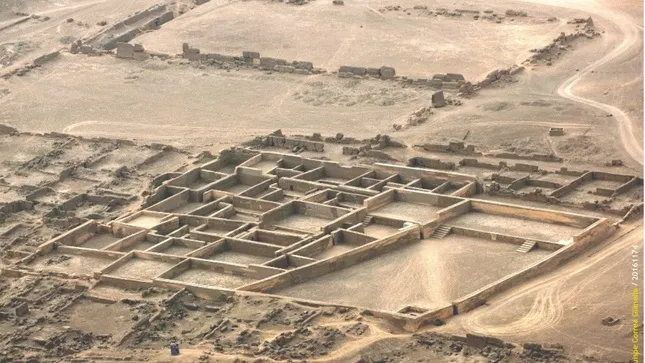Cajamarquilla is an ancient archaeological site located near Lima, Peru. It is one of the largest pre-Hispanic ruins in the coastal region, believed to have been built around 200 AD. The site was a major urban center, possibly serving as an administrative and commercial hub during its peak. Despite its proximity to modern development, Cajamarquilla has retained much of its structure, offering valuable insights into the lives of the people who once thrived there.
Get your dose of History via Email
Historical Background of Cajamarquilla
Archaeologists stumbled upon Cajamarquilla in the 20th century, recognizing its significance swiftly. The site was built by the Lima culture, a pre-Incan civilization known for its skill in constructing adobe complexes. Later, the Wari Empire, which expanded across ancient Peru, inhabited the site. Cajamarquilla’s strategic location made it a bustling trade center, connecting the Andes to the coast. It also witnessed historical events, including interactions with the Inca Empire.
The discovery of Cajamarquilla was a breakthrough in understanding the Lima culture. Researchers have been piecing together its history since its unearthing. The site’s architecture suggests it was a planned urban settlement. Its builders demonstrated advanced knowledge of urban planning and construction techniques. The Lima culture’s decline saw the Wari culture take over, leaving behind their own cultural imprints.
Cajamarquilla’s history is not just about its creators but also its later inhabitants. After the Wari, the site saw a decline in prominence. However, it remained inhabited until the Late Intermediate Period. The site’s longevity indicates its importance to various Andean cultures. It also hints at a complex history of cultural transitions and adaptations.
The site has not only historical but also cultural significance. Cajamarquilla was likely a melting pot of cultures, given its role in trade and commerce. This aspect of its history is crucial in understanding the pre-Columbian societies of coastal Peru. The site’s interaction with the Inca Empire further adds to its historical importance, providing a glimpse into the dynamics between different Andean cultures.
Cajamarquilla’s discovery and subsequent studies have shed light on the pre-Hispanic era of Peru. The site’s excavation continues to reveal its secrets, offering a window into the past. Its history is a testament to the ingenuity and resilience of the Andean people. The site stands as a silent witness to the ebb and flow of empires and cultures in ancient Peru.
About Cajamarquilla
Cajamarquilla is a testament to the architectural prowess of its builders. The site spans over 150 hectares, making it one of the largest adobe structures in the Americas. Its walls, some standing six meters high, were constructed using millions of mud bricks. The complex includes pyramids, plazas, and residential areas, all indicative of a highly organized society.
The construction methods of Cajamarquilla reveal much about the Lima culture. They used adobe bricks, a material well-suited to the coastal climate. The layout of the site shows a clear division of space for different purposes. This includes areas for administration, production, and possibly religious activities. The use of canals for irrigation and drainage demonstrates their advanced understanding of engineering.
Architectural highlights of Cajamarquilla include its massive walls and intricate network of passageways. The walls served as defensive structures and as a means to control the flow of people and goods. The passageways, some narrow and winding, suggest a complex urban design. This design may have been intended to manage the population or for ceremonial purposes.
The building materials of Cajamarquilla have withstood the test of time. The adobe bricks, made from earth, water, and straw, have endured for centuries. This durability is a testament to the builders’ skills and the materials’ suitability for the local environment. The preservation of these materials allows for ongoing study and conservation of the site.
Cajamarquilla’s construction reflects the social and political organization of its inhabitants. The scale and complexity of the site imply a high degree of social stratification and centralized control. The presence of large public spaces suggests that Cajamarquilla was not only a place of residence but also a center for communal activities. Its architecture provides a tangible link to the past, offering clues to the daily lives of its ancient inhabitants.
Theories and Interpretations
Theories about Cajamarquilla’s purpose abound, with some suggesting it was a trade and administrative center. Its location near the Rimac River would have facilitated commerce between the highlands and the coast. This strategic position implies that Cajamarquilla played a significant role in the regional economy.
Mysteries shroud Cajamarquilla, particularly regarding its sudden abandonment. Some theories propose that environmental changes or seismic events led to its decline. Others suggest that shifts in trade routes or political upheavals could have contributed to its desertion. These theories are still under investigation by historians and archaeologists.
Interpretations of Cajamarquilla’s structures often rely on matching them to historical records. However, the absence of written records from the Lima culture complicates this task. Archaeologists must instead rely on artifacts, architecture, and oral traditions to piece together the site’s history. This process involves a combination of scientific analysis and educated conjecture.
Dating of Cajamarquilla has employed various methods, including radiocarbon dating and stratigraphy. These techniques have helped establish a timeline for the site’s occupation and use. The results suggest that Cajamarquilla was in use for over a thousand years, with different cultures leaving their mark on the site.
Theories about Cajamarquilla continue to evolve as new discoveries are made. Each finding adds a piece to the puzzle, slowly bringing the full picture of Cajamarquilla’s past into clearer focus. The site remains an active area of research, with each layer of excavation revealing more about the ancient Andean world.
At a glance
Country: Peru
Civilization: Lima culture, later inhabited by the Wari Empire
Age: Constructed around 200 AD

